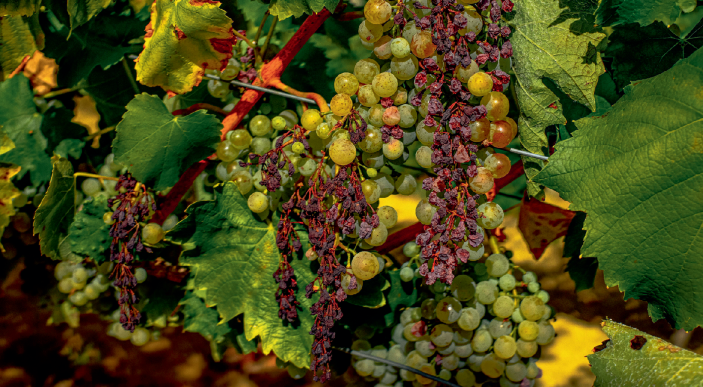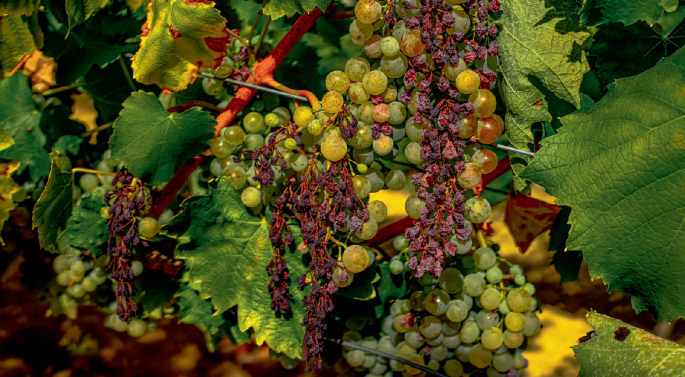All over the world, farmers are finding new ways to adapt to climate change. But these innovations risk severing connections to the land that have been shaped over millennia.
It is late September and the season’s rice crop is still ripening, not quite ready for harvest after a long, hot summer. But rather than being on the terraces of northern Vietnam or in the paddies of South Korea, this rice has been grown as part of a first-of-its-kind field trial on a farm about twenty miles north of Cambridge, UK. Initial results for the trial look promising — rice cultivation is feasible in the highly productive fenlands of the east of England.

Droughted grapevine in a French vineyard.
Credit: sportpoint/Alamy
Part of a programme designed by the UK Centre for Ecology and Hydrology (UKCEH), this research aims to assess the viability of growing crops such as rice, soy and chickpea across the UK — crops better suited to the future climate of the country1. Known as crop shifting or switching, the strategy of optimizing crop distribution to adapt to changing climates is likely to be an effective and necessary intervention across global farming systems. Several modelling studies have shown that redistribution of crops into more sustainable configurations can maintain yields, reduce agricultural input use and enhance farmer incomes, prompting the development of new local markets2,3,4.
One crop that is already thriving in England is grapevine, representing 36% of the country’s soft fruit crop5. Winemakers in the south have taken advantage of increasing temperatures in the famously cold, damp country, driving the emergence of a booming viticulture sector. Although these shifts in climate suitability represent an exciting opportunity for British winemakers, for growers in the traditional wine regions of Europe they signal looming disaster. Extreme weather has pushed European viticulture to its limits, with more than 70% of production at risk. As droughts reduce yields, higher temperatures have substantially advanced grapevine phenology, altering wine quality and flavour profiles6.
Another obvious adaptation to the encroaching adverse conditions is to grow more drought-tolerant varieties and alter vineyard management strategies; however, for viticulture this is not so straight forward. Geographical region, grape variety, growing methods and winemaking processes are legally defined characteristics in the industry. Developed over centuries, viticulture traditions are deeply rooted within the history of wine regions; an intangible source of cultural heritage that connects the traditional methods of wine production practiced by vintners to the landscape. If simply switching grapevine variety risks disrupting regional identity, switching to a different crop altogether would be entirely more problematic.
In Ethiopia, similar climate-induced shifts in coffee cultivation are expected to occur. One study revealed that 39–59% of the growing regions of the country, which is widely considered to be the birthplace of coffee, could experience climatic changes that render them unsuitable for production7. Although crop redistribution to better-suited regions is feasible, providing resilience to the Ethiopian coffee sector at a nationwide level, it may be of little comfort to the smallholder farmers whose traditional ways of life are now jeopardized.
The quantitative effects of climate change on agricultural yields, environmental sustainability and market economics are well-established. But there are also less tangible effects equally worthy of our attention. When a farmer is no longer able to grow the crops that have been farmed on their lands for generations in the traditional ways, it threatens their rural identity and cultural heritage. Deep knowledge of the landscape, developed over centuries and held in community memory, is in danger of being wiped away by the far-reaching consequences of climate change8. Yet this knowledge, a manifestation of the long histories of interactions between local communities and the natural environment, is critical to building resilience towards climate variability.
In 2023, the Vision for Adapted Crops and Soil (VACS) initiative was launched by the US Department of State in partnership with the African Union and the Food and Agriculture Organization (FAO). The aim of the initiative is to create more resilient food systems across Africa by identifying the crops that have the most potential in a changing climate, drawing on the vast genetic diversity in under-utilized opportunity crops9. Traditional food crops such as cowpea, teff and okra have typically not been incentivized by agricultural policies, leading to the underdevelopment of value chains and seed propagation systems. Incorporating these climate-adapted species into regional farming systems and scaling-up their production optimizes crop distributions in a way that both leverages and preserves Indigenous knowledge.
Adaptions to climate change, such as the deployment of gene-edited, drought-tolerant varieties or crop switching, can open doors to diversified agricultural systems and new markets to stimulate local economies. As the effects of climate change intensify at unprecedented rates, such adaptations are crucial to securing global food production. However, alongside the potential gains from such innovations, we should always be mindful of how their introduction can affect long-established rural communities.

